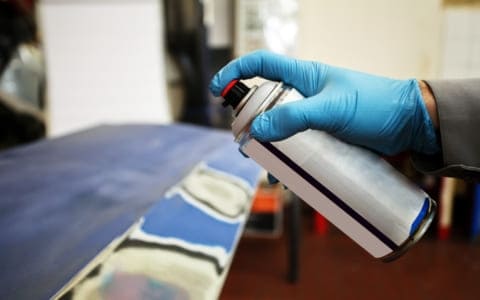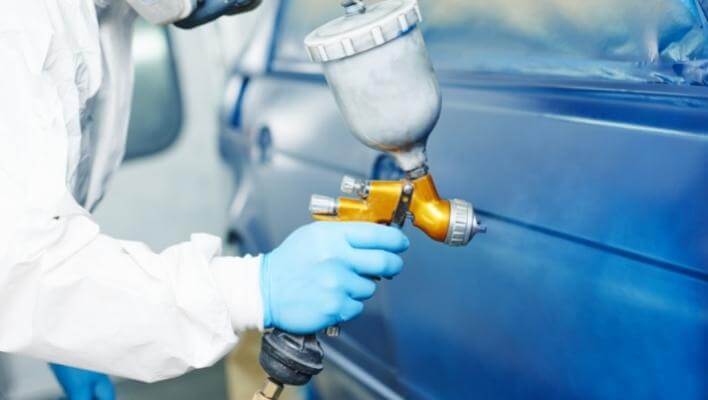Spray paint is a widely chosen option for rapidly and efficiently coating surfaces in various industries and do-it-yourself (DIY) projects. While it offers a rapid aesthetic transformation, and is frequently utilized for rapid makeovers in various projects. However, there are concerns regarding its use indoors due to the emission of VOCs. However, these compounds can result in health issues like headaches and nausea when inhaled. This article explores the dual nature of spray paint—its effectiveness in quick transformations and the importance of addressing potential health risks, particularly in indoor settings.

Table of Contents
- Is Spray Paint Toxic? Quick Note
- Symptoms of spray paint poisoning
- Why is Spray Paint Toxic?
- How long does spray paint poisoning last?
- Spray painting hazards And Control Measures
- Good Ventilation:
- Protect Yourself:
- Containment is Key:
- Choose Safer Paints:
- Keep Equipment Clean:
- Training Matters:
- Spraying Distance:
- Dispose of Waste Properly:
- is spray paint toxic on skin?
- Is Spray Paint Toxic After It Dries?
- Is Rust-Oleum Spray Paint Toxic Or Non Toxic?
- Is spray paint toxic to dogs?
- What happens if I breathe in spray paint?
- Is it safe to use spray paint indoors?
- What to do after inhaling spray paint fumes?
- Can paint fumes damage brain?
- Conclusion:
- Martina Hitchcock
Is Spray Paint Toxic? Quick Note
Spray paint poses risks due to volatile organic compounds (VOCs) releasing toxic fumes. To reduce these risks, use it outdoors, in well-ventilated areas, and consider low-VOC or water-based options. While wet, spray paint fumes can cause irritation, but once dry, it’s generally non-toxic and safe to touch. Aerosol paint fumes are hazardous during use, but they disperse after the paint dries.
Symptoms of spray paint poisoning
The symptoms of spray paint poisoning can vary depending on the extent of exposure, but they may include:
- Respiratory Issues: Difficulty breathing, coughing, or wheezing.
- Headaches: Persistent or severe headaches.
- Dizziness: Feeling lightheaded or dizzy.
- Nausea: Upset stomach or vomiting.
- Eye Irritation: Redness, itching, or watering of the eyes.
- Skin Irritation: Rash or irritation on the skin.
Useful Resource: Learn about the flammability of acrylic spray paint!
Why is Spray Paint Toxic?
The safety of spray paints depends on their ingredients, specifically Volatile Organic Compounds (VOCs). VOCs, like propane, butane, acetone, xylene, and toluene, are gases released from these paints.
Exposure to them can have harmful health effects. Different brands vary in the type and amount of VOCs they use. Although the initial concentration of these gases may seem low, prolonged exposure can lead to long-term health issues instead of immediate poisoning.
Spray paints commonly contain acetone, carbon black, xylene, toluene, n-butyl acetate, ethylbenzene, methyl ethyl ketone, magnesium silicate, liquefied petroleum gas, and propylene glycol monobutyl ether. Inhaling fumes from spray paint, whether during application or when exposed in the open, allows these substances to be easily breathed in, posing potential health risks.
It’s crucial to understand that not all chemicals are present in every brand or type of spray paint. Wearing protective gear and using these paints in well-ventilated areas can help reduce health risks.
Useful resource: What’s the minimum age requirement to purchase spray paint!
How long does spray paint poisoning last?

People often ask, How Long is Spray Paint Toxic?
The duration of symptoms resulting from exposure to spray paint can vary. In mild instances, symptoms tend to improve once the individual is no longer in contact with the paint and has had access to fresh air. However, in more serious situations or if you’ve been around spray paint for a long time, the symptoms might stick around and you’ll need to see a doctor.
Mild symptoms such as headaches, dizziness, and respiratory irritation typically resolve within a few hours to a day after discontinuing exposure.
With good ventilation and open windows, you can clear out spray paint fumes and smells in about 36-48 hours, but stronger paint types might take up to a week to completely go away.
If you suspect that you may be dealing with symptoms of spray paint poisoning, it is important to promptly seek medical assistance. Tell the doctor all the details, like what type of paint it was and how long and how much you were around it, so they can figure out the best way to treat you.
Spray painting hazards And Control Measures
Spray paint poses health risks due to the presence of Volatile Organic Compounds (VOCs) like acetone, xylene, and toluene, which can result in immediate symptoms such as eye, nose, and throat irritation, headaches, dizziness, and nausea.
Prolonged exposure may lead to more severe issues such as respiratory problems, liver and kidney damage, and long-term conditions like asthma. Wearing proper protective gear is crucial, as poor quality equipment can increase health risks.
Here are the steps to minimize the harmful effects of spray paint fumes.
Good Ventilation:
Paint in well-ventilated areas or booths with proper exhaust systems.
Protect Yourself:
Wear the right gear: respirator, gloves, coveralls, and eye protection.
Containment is Key:
Enclose the painting area to keep fumes and overspray in check.
Choose Safer Paints:
Pick paints with low VOC or go for water-based options.
Keep Equipment Clean:
You need to clean your spray equipment after using it instantly.
Training Matters:
Train workers on safe practices and equipment use.
Spraying Distance:
Maintain proper spraying distance, and be mindful of aerosol cans.
Dispose of Waste Properly:
Follow guidelines for getting rid of used paint cans and other waste and have plans in case of spills or accidents and keep emergency equipment handy.
is spray paint toxic on skin?
Spray paint may pose risks with solvents such as acetone, toluene, and xylene, causing irritation to the skin, eyes, and respiratory system. Prolonged exposure can result in neurological problems and organ damage. According to NFPA 33 Code, it is advised to maintain a 20-foot separation distance from the spray area for safety. You can remove spray paint from the skin, scrub vigorously with an old toothbrush, dish soap, and warm water for 2-3 minutes.
Is Spray Paint Toxic After It Dries?
When dealing with indoor spray painting, it’s crucial to be aware of potential toxicity. After spray paint has fully dried, it’s generally safe to touch, as most harmful substances have evaporated. However, caution is necessary during application and drying, as inhaling fumes from incompletely cured paint can be harmful.
It’s essential to ensure the paint is completely dry before deeming it safe. Ingesting dry spray paint may cause minor gastrointestinal upset, but choking on oil-based paints, which contain more toxic solvents, can pose a greater risk. Always adhere to safety guidelines and work in well-ventilated areas.
Is Rust-Oleum Spray Paint Toxic Or Non Toxic?
Inhaling Rust-Oleum spray paint fumes can be harmful, causing irritation to the eyes, nose, throat, and lungs. Additionally, ingesting the paint is risky and can lead to lung damage. It’s important not to breathe in the fumes while using Rust-Oleum spray paint. Once the paint is completely dry, the solvents evaporate, making it non-hazardous and safe for use on items such as toys and furniture.
Is spray paint toxic to dogs?
Paint fumes are harmful to dogs. They might sniff or lick paint, getting sick. Keep pets away when painting or put the paint out of their reach. Paint is toxic for animals.
What happens if I breathe in spray paint?
Inhaling spray paint fumes for an extended period can result in headaches, dizziness, and nausea, particularly in poorly ventilated areas or during extensive paint use. Deliberately inhaling paint fumes for recreational purposes is extremely risky and can be fatal.
The chemicals in paint fumes, called VOCs, can cause problems like irritation, headaches, dizziness, vision issues, and temporary memory loss with short-term exposure.
Is it safe to use spray paint indoors?
Spray painting indoors is okay, but it’s important to have good ventilation. Without proper ventilation, the fumes can be irritating and cause symptoms like headaches and nausea. So, ensure a well-ventilated space when using spray paint indoors. .
What to do after inhaling spray paint fumes?
Inhaling spray paint fumes can harm your health, especially your lungs. If you have already inhaled it, consider these ways to clear your lungs:
- Move to a well-ventilated area immediately.
- Increase ventilation to disperse the fumes.
- Allow your body to recover with rest and slow, deep breaths.
- Stay away from the area with paint fumes and avoid using spray paint in confined spaces without proper ventilation.
- It help remove excess mucus by coughing.
- Use body positions to drain mucus from your lungs.
- Physical activity can aid in lung clearance..
- Use an air purifier to reduce airborne particles.
- Smoking further harms the respiratory system.
- Alcohol can worsen respiratory issues, so it’s best to avoid it. You can learn more about clearing lungs from spray paint here in this detailed guide!
Can paint fumes damage brain?
Inhaling paint fumes can harm the brain. The chemicals in paint and similar substances can cause long-term issues with thinking. Chronic exposure to these substances can damage different parts of the brain. The strong chemicals in paint fumes are dangerous and should not touch your body.
The chemicals in paint can potentially damage brain cells by targeting the protective layer around the brain. Once this layer is damaged, the fumes can enter the brain cells, reducing their number and causing damage to connections between them.
The more you’re exposed to, the more damage can occur. Therefore, it is important to prioritize your safety by using effective protective gear when handling these substances.
Conclusion:
In summary, spray paint contains potentially harmful substances like volatile organic compounds (VOCs), posing health risks upon prolonged exposure. Ensuring good airflow, using the right protective equipment, and following safety instructions are vital when working with these products.
Exploring less toxic paint options and adopting responsible disposal practices can contribute to a safer environment. Overall, being aware of the potential hazards and making informed choices is essential for minimizing the negative impact of spray paint on health and well-being.

Martina Hitchcock
Martina Hitchcock is a versatile author with expertise in different fields. As a paint sprayer expert, she has in-depth knowledge of paint spraying techniques, tools, and equipment. Martina is also an experienced home remodeler who has worked on various projects, including kitchen and bathroom renovations, flooring installations, and room additions. Her knowledge of home improvement and remodeling is extensive, and she enjoys sharing her insights and tips with readers. You can follow her on Facebook.


